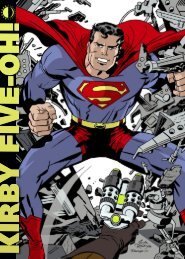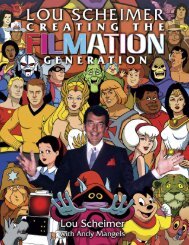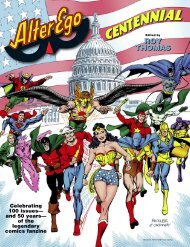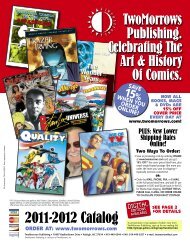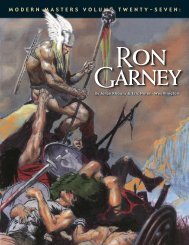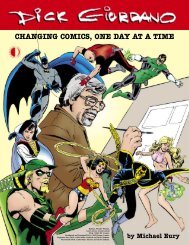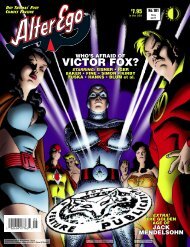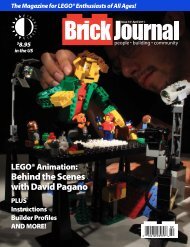Download - TwoMorrows
Download - TwoMorrows
Download - TwoMorrows
You also want an ePaper? Increase the reach of your titles
YUMPU automatically turns print PDFs into web optimized ePapers that Google loves.
(left) A sample page Al worked up circa 1947-48 in an attempt to<br />
get work from Fiction House.<br />
(above) A 1950 portfolio illustration.<br />
Artwork © Estate of Al Williamson.<br />
love affair for comics and cinema began, introducing him to<br />
fantastical worlds and creativity. In 1940, during the Golden<br />
Age of comics, he traded his skates for a stack of Pacquins (a<br />
Spanish-language comics magazine) and never looked back<br />
as he searched for more comics wherever he travelled. Riding<br />
on his enthusiasm, he began to fill up notebooks of drawings<br />
emulating his favorite strips, like Flash Gordon, his favorite<br />
hero in the funny books and cinema.<br />
After the break-up of his parents, Williamson and his mother,<br />
Sally, returned to the States in 1943, originally to San Francisco<br />
and a year later back to his hometown of New York City.<br />
In Manhattan the youngster—one of the first true fanboys of<br />
the comics medium—found himself in the heart of the comics<br />
industry, and he visited the syndicates themselves in search<br />
of more comics or anything else comics-related he could get<br />
his hands on be it actual original art, clippings, tear-sheets,<br />
or proofs. All he wanted was to study the art techniques and<br />
production process of his favorite creators up close. It wasn’t<br />
very long before Williamson started taking art classes taught<br />
by legendary Tarzan artist Burne Hogarth and befriending<br />
fellow students like Wally Wood and Roy Krenkel. By 17<br />
he broke into the industry doing a few spot illustrations for<br />
Famous Funnies.<br />
As comic fans and artists tend to do, Williamson soon<br />
became great friends with other kindred spirits like Frank<br />
Frazetta, Angelo Torres, George Woodbridge, and future<br />
Mad editor Nick Meglin—all in the infancy of their respective<br />
careers. Together these young men pushed one another to<br />
better themselves, and they collaborated on many artistic assignments<br />
in those early days. At the height of legendary EC<br />
Comics line, Williamson was a Wunderkind cutting his teeth<br />
on now-classic comics like Tales from the Crypt, The Vault of<br />
Horror, Weird Fantasy, and Weird Science amongst others.<br />
Only in his early 20s, EC Comics allowed him to cement his<br />
name and show the world that he was an artist with incredible<br />
range, who could draw science fiction as well as any crime<br />
story without missing a beat.<br />
After 1954 the years were lean for all comics professionals—and<br />
EC in particular—due to the public outcry and wave<br />
of censorship triggered by a Senate hearing investigating the<br />
link between juvenile delinquency and comics. During this<br />
unglamorous period, Williamson worked for nearly every<br />
publisher in New York, and for low page rates—primarily at<br />
Atlas Comics, but also other outfits like ACG, Charlton, Dell,<br />
and Harvey. On this rugged road, sometimes the work was<br />
done quickly and suffered for it, but he persevered because<br />
he had a solid foundation and, frankly, only the best artists<br />
survived this comics crash.<br />
Into the 1960s Williamson continued perfecting his craft<br />
and made a pivotal move to work as an assistant to artist John<br />
Prentice on the newspaper strip Rip Kirby, an Alex Raymond<br />
creation. Working and following Prentice’s lead, Williamson<br />
began to develop a sense of self-discipline and professionalism<br />
that he felt he was lacking next to the all-business approach<br />
of the older Prentice. Here he began understanding<br />
how to effectively use perspective and blacks in his layouts<br />
and inking. He now had all the tools to make even the most<br />
mundane of civilian scenarios look compelling and interesting.<br />
By the end of the experience, he would ghost art not only<br />
DRAW! SUMMER 2012 49



